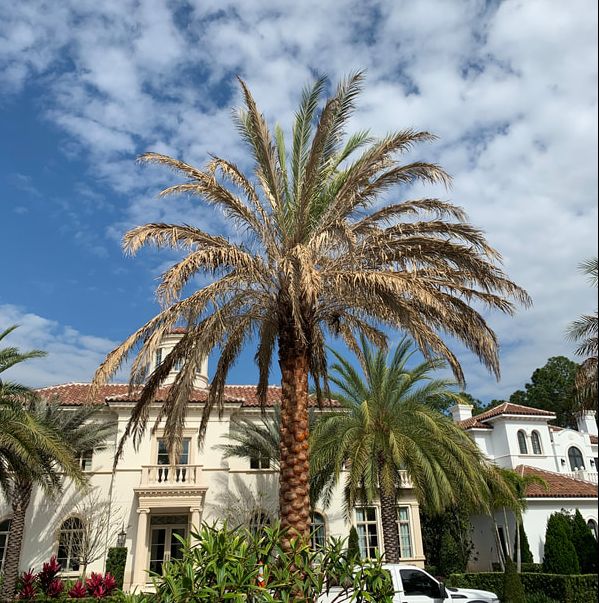
Protect Our Beautiful Palm Trees
Lethal Bronzing Disease Of Palm Trees
Lethal Bronzing (until recently known as Texas Phoenix Palm Decline) is a lethal bacterial (phytoplasma) disease of palms. This disease is taking its toll on palm trees in Central Florida and is spreading rapidly. The disease is transmitted to palm trees through feeding by certain planthopper insects. Unlike many other palm diseases, Lethal Bronzing is not likely to be spread by pruning equipment. Current recommendations by University of Florida researchers is to remove palms that have been diagnosed with Lethal Bronzing through laboratory testing. Additionally, it is recommended to preventively-treat palm trees that are NOT in decline but are in close vicinity of infected specimens, with oxytetracycline (OTC) antibiotics. This treatment is administered through trunk injection about every three months.
EPLS is proud to offer preventive applications of OTC on a quarterly basis to protect these beautiful palms from this rapidly-spreading disease. To schedule a proposal or treatment, simply contact us at info@epls1.com or call us at (407) 532-8188.
Why Choose EPLS To Provide Treatment For Your
Lethal Bronzing Disease Of Palm Trees.
- We are licensed and insured.
- We sanitize our drill bits using alcohol AND heat (flame torch) between each injection treatment. Avoid contractors who do not sanitize their equipment between each and every palm, including on the same property, as this practice can transfer palm diseases including those caused by Ganoderma, Pythium, Thielaviopsis, and Phytophthora.
- We administer each OTC injection treatment through a new injection site in the palm. Avoid contractors who re-drill treatment sites as this may result in poor product absorption and increases the possibility of tissue necrosis and secondary disease incidence.
- We send samples to the laboratory on the same day of sample collection, via FedEx next day delivery. Avoid contractors who mail the samples through standard mail as the quality of the sample may be compromised by the time it arrives at the laboratory.
Common Central Florida Palm Tree Susceptible To Lethal Bronzing Include The Following:
- Phoenix sylvestis – Sylvester Palm
- Phoenix dactylifera – Date Palm, ‘Medjool’ most commonly seen in our area
- Phoenix canariensis – Canary Island Date Palm
- Phoenix roebelenii – Robellini Palm
- Sabal palmetto – Sabal Palm
- Syagrus romanzoffiana – Queen Palm
- Bismarckia nobilis – Bismarck Palm
- Livistona chinensis – Chinese Fan Palm
- Adonidia merrillii – Christmas Palm
- Butia Capitata – Pindo Palm
Of the above host list, Sylvester Palm, Date ‘Medjool’ Palm, and Canary Island Date Palm are the most commonly seen infected species in the Central Florida area.
How Long Should Palms Trees Be Injected For To Prevent Lethal Bronzing Disease?
Preventive applications targeting Lethal Bronzing Disease should be administered every three months, indefinitely. As more research studies are conducted, treatment recommendations may change. We will update this site as updated treatment protocols are released.
Will The Treatment For Lethal Bronzing Disease Manage Other Palm Diseases?
No. Oxytetracycline (OTC) administration will only protect against Lethal Bronzing Disease.
Symptoms of Lethal Bronzing infection include dieback of the palm from the oldest growth (lowest row of leaves) upwards. Dieback begins at the leaf tips. Sometimes, the spear leaf dies following the dieback of about one-third of the canopy. The time frame of onset of infection to palm death is relatively quick – anywhere from several weeks to six months. Early onset of decline closely resembles nutrient deficiencies and other palm diseases.
The only way to conclusively diagnose Lethal Bronzing infection is through a laboratory analysis (PCR) sample of wood shavings from the trunk of the palm.
Our current recommendations coincide with those of University of Florida experts. We recommend removing any palm with a confirmed infection by Lethal Bronzing. Susceptible palm trees near infected palms should be treated with antibiotics as noted above. Post-infection treatments may promote the longevity of infected palms but will not cure the palms, and such palms serve as a source of infection regardless of antibiotics administration.
If a palm tree is suspected to be infected by Lethal Bronzing, it is important to not only test the symptomatic palm but also test susceptible palms in the landscape that are not showing symptoms, as they may be infected but not yet symptomatic. If an asymptomatic palm is tested positive for Lethal Bronzing, then it too should be removed.
For more information, please contact us at (407) 532-8188 or info@epls1.com. Click here for a Lethal Bronzing Pest Alert from the Florida Division of Plant Industry.
Check Out Our Interview On Fox 35 With Matt Trezza:
We were honored to have Matt Trezza from Fox 35 News interview Roi Levin! Please note the following clarifications to the news clip:
- Decline symptoms "spreading from the bottom to the top" refers to the dieback from the older (bottom) leaves to the newest (top) leaves.
- Antibiotic injections cost anywhere from $75-$100 per palm tree.
- Palms in the Phoenix genus (see above) are most susceptible, but other palm species, including Queen Palms and Sabal Palms, can become infected.
